Milestones
Milestones
Plana
Plana del Vent power plant successfully back in operation
18 January 2022
In Spain, Alpiq successfully recommissions the Plana del Vent gas-fired combined cycle power station in mid-January 2022 after around two years. This was preceded by extensive repair and maintenance work on a defective power train. The steam turbine was replaced during the complex inspection, which was particularly challenging given the Covid 19 pandemic and the lack of spare parts compounded by shortages of skilled workers.
Alpiq made efficient use of the repair time for further overhaul work on the plant. Thanks to its total capacity of 800 MW, Plana del Vent is able to supply enough electricity to cover the annual consumption of two million households.
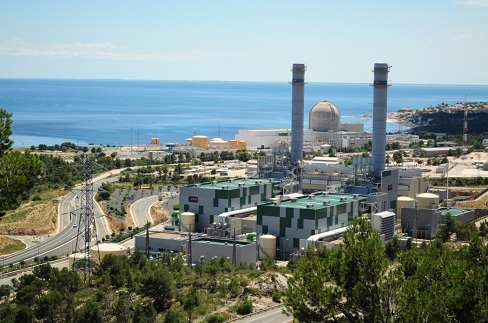
Plana del Vent gas-fired combined cycle power plant in Spain.
Share
Shareholders give Alpiq room for manoeuvre
19 January 2022
The energy markets are thrown out of balance for several weeks.
The outage of numerous French nuclear power plants as well as cold temperatures cause prices to soar on an unprecedented scale. The extreme prices increase the liquidity and credit risks for all market participants, primarily impacting large electricity producers that had taken the precaution of hedging their power production in advance. These hedges require high security deposits in case the terms of the agreement are not met. The company receives these back in full once the contract has been fulfilled.
To maintain the company’s room for manoeuvre, the shareholders provide Alpiq with temporary liquidity of up to CHF 300 million.
The operating business is not affected by this. Alpiq has a stable operating business with high profitability.
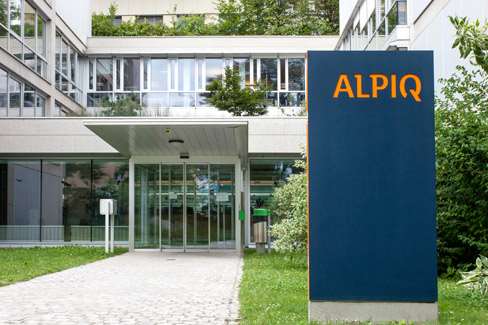
Alpiq headquarters in Lausanne.
Gondosolar
Gondosolar - Project for the construction of a photovoltaic installation in the Valais Alps
7 February 2022
Three partners, assisted by Alpiq, are planning a large photovoltaic installation above the Valais village of Gondo. Thanks to its prime position at over 2,000 metres above sea level, Gondosolar will produce around 23.3 million kilowatt-hours (kWh) of electricity a year – the majority of which in the winter half-year. The municipality of Gondo-Zwischbergen, Energie Electrique du Simplon SA (EES; Alpiq’s share: 81.97 %) and the project initiator, Renato Jordan, who owns the plot of land at the Alpjerung location, are backing this project. The project envisages the installation of 4,500 bifacial solar elements on an area of around 100,000 square metres. Each solar element consists of 8 PV modules. The investment amounts to around CHF 42 million.
With a total installed capacity of 18 MW, Gondosolar will produce around 23.3 million kWh of electricity. Due to the altitude, the planned project will produce around twice as much electricity per square metre as a comparable facility in the Swiss Plateau. In addition, Gondosolar will produce significantly more winter electricity per area than a PV installation in the lowlands. Gondosolar will thus make an important contribution to the expansion targets for power production from solar energy set by both the federal government and the canton of Valais. The installation is expected to be commissioned in 2025.
The location above Gondo, a village on the Italian border, is ideal for the use of solar energy. It does not affect protected areas and is not considered critical by experts in terms of natural hazards. The impact on the environment, biodiversity and landscape is relatively low. The planned ground-mounted PV installation is not visible from populated areas. The electricity will be transported via an underground cable and the nearby medium-voltage grid to the existing Gabi substation.
In December 2022, Prafleuri, a second major Alpine photovoltaic project in which Alpiq is involved will be launched in the canton of Valais. Further projects are in the pipeline.
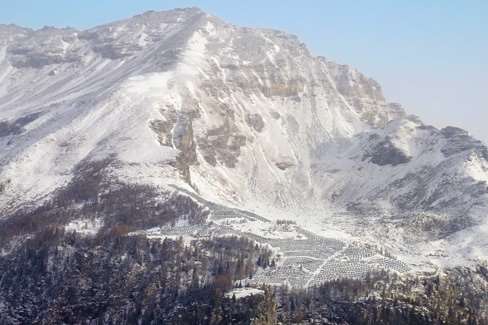
Visualisation of the Gondosolar photovoltaic installation.
Electricity
Electricity prices soar again following start of Russia’s attack on Ukraine
24 February 2022
On 24 February, Russia invades Ukraine. War begins. Major Ukrainian cities are under fire from missiles. Millions of people are suddenly on the run. Europe’s solidarity with Ukraine is unprecedented.
The Russian invasion of Ukraine also shakes the energy markets to their very core. Uncertainty pushes prices into new dimensions. It becomes apparent how dependent Europe is on Russian commodities, especially gas. Sanctions are imposed on Russia. The war exacerbates the existing energy crisis further. Some energy companies flounder and need government support.
Extreme prices and the high volatility on the European energy markets greatly increase liquidity needs for the entire industry. Energy producers, in particular, must temporarily make high security deposits for the production they sell. However, the company receives these back in full once the contract has been fulfilled.

Electricity prices continue to rise.
ASFA
Alpiq welcomes Act on Subsidiary Financial Assistance to Rescue Systemically Critical Companies to ensure security of supply
4 May 2022
Alpiq supports the federal government’s efforts to secure Switzerland’s power supply. The federal government presents a bill intended as a preventive subsidiary measure. It wants to compel systemically important energy companies to submit to a federal bailout scheme. Since the market conditions are extremely tense and the high volatility on the energy markets leads to systemic risks, this type of commitment can be purposeful and stabilising. It can relieve speculation and tension on the market as the companies concerned have sufficient liquidity. However, it is not possible to rule out all contingencies of a pan-European upheaval.
This measure is intended to ensure security of supply for the general population as well as businesses in the current extreme market environment impacted by geopolitical forces. In its response to the broad review, Alpiq draws attention to several critical points. Many of the suggestions are incorporated into the legislation during the subsequent legislative process. On 30 September 2022, the National Council and Council of States approved the urgent Federal Act on Subsidiary Financial Assistance to Rescue Systemically Critical Companies in the Electricity Industry and adopted this at 1 October 2022. The rescue package is limited until the end of 2026.
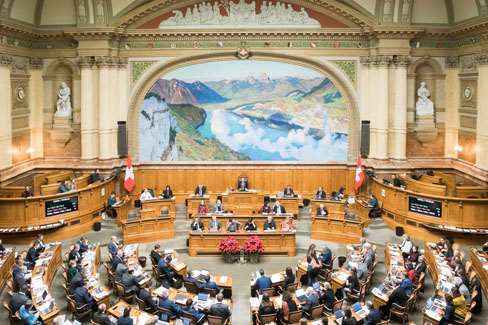
The Parliament in Bern.
Photo: Parlamentsdienste 3003 Bern / Goran Basic
NdD
Nant de Drance is an essential cog in the security of supply
1 July 2022
Fourteen years after the start of construction work, the Nant de Drance pumped storage power plant goes into operation on 1 July 2022. Thanks to its six extremely flexible machines and a capacity of 900 MW, Nant de Drance power plant is set to play a key role in the stabilisation of the Swiss and European electricity grid. The plant is built 600 metres into a mountain in a cavern between the Emosson and Vieux Emosson reservoirs in the Finhaut municipality of Valais. The highly flexible machines with a capacity of 150 MW each make it possible to switch from pumping at full power to turbining at full power in less than five minutes, i.e. from -900 MW to +900 MW. The machines are at the cutting edge of technology with the speed of the machines varying in both pump and turbine mode, allowing for optimum operating efficiency.
The Vieux Emosson reservoir holds 25 million cubic metres of water, which represents a storage capacity of 20 million kWh. Its output, storage capacity and flexibility allow Nant de Drance to play a crucial role in stabilising the electricity grid. In face of the growth of new renewable energies such as wind and photovoltaic whose production is intermittent, a great deal of flexibility is required to maintain continual equilibrium in the electricity grid between production and consumption. Nant de Drance works like a gigantic battery which allows excess electricity to be stored in the short term or to feed this energy back into the electricity grid when demand exceeds production.
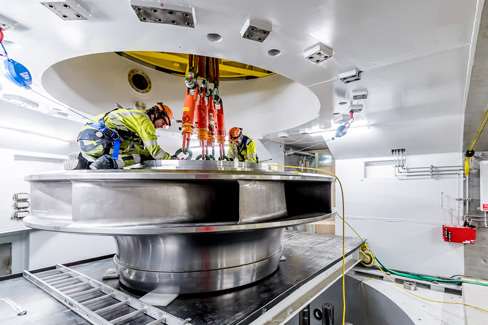
Assembling a pump turbine.
Photo: Nant de Drance / Sébastien Moret
PD
Political debates surrounding price caps gain ground
August 2022
Hopes for a quick end to the war in Ukraine are shattered. Russia’s President, Vladimir Putin, uses natural gas as a political lever. After limited amounts of natural gas continued to flow from Russia to Europe via the Nord Stream 1 pipeline in spring, these deliveries are first halted temporarily in July – under the pretext of maintenance – and then later stopped completely. At the same time, the prolonged period of dry weather in combination with an unusually long heatwave mean that water levels in the rivers of Western Europe are very low. This not only restricts river traffic and thus the transport capacities for raw materials such as fuels, but also the cooling of nuclear power plants via river water is only possible to a limited extent. This again leads to higher prices across the board, not only for gas and electricity, but also for fuels.
Europe’s population and economy struggle with record energy prices. An energy shortage in the coming winter is also looming. Alternative procurement strategies are initiated and LNG terminals are planned for the delivery of liquid gas. Energy-saving measures and campaigns are launched to save energy for the coming winter. In the summer months, political efforts to intervene in the market in a regulatory manner also increase.
At the end of August, prices reach their highest point to date. Numerous energy-intensive industrial companies can no longer maintain their production at the high energy prices.

Electricity prices climb to unprecedented heights.
Visit
Nant de Drance: Visit to power plant leaves lasting impressions
9 September 2022
The Nant de Drance pumped storage power plant in Valais with a capacity of 900 MW is inaugurated on 9 September 2022. The day will go down as a key date in the history of Nant de Drance. It marks the end of a 14-year construction site with up to 650 workers, technicians and engineers from across Europe. Federal Councillor Simonetta Sommaruga and the President of the Cantonal Council of Valais, Roberto Schmidt, take part in the official inauguration, which is dedicated to today’s youth, future generations and the future of energy.
The Nant de Drance pumped storage power plant project officially started on 8 September 2008. Fourteen years later, the opening ceremony for this monumental construction takes place. The power plant has been in operation since 1 July 2022 and is proving to be extremely reliable. The flexibility and availability of its machines are its distinguishing features, enabling it to respond to fluctuations in the electricity grid very quickly and to adapt to the market requirements. Shareholders Alpiq (39 %), SBB (36 %), IWB (15 %) and FMV (10 %) have access to the power plant’s production and pump capacities in proportion to their stake in the company, manage energy in line with market needs and thus contribute to the stabilisation of the Swiss and European electricity grid.
The inauguration celebrations are dedicated to the youth and future generations, in keeping with Nant de Drance’s central role for the future of energy. Children from Valais perform musical interludes for most of the official ceremony. Schoolchildren from the neighbouring primary schools visit the power plant on 8 September 2022. More than 2,000 people explore the plant at open day events on 10 and 11 September 2022. Lastly, more than 700 Alpiq employees meet up at the large staff party in Sion on 12 and 13 September 2022, including a tour of Nant de Drance and the Emosson reservoir. Visiting the power plant is a unique experience for all those who take part.
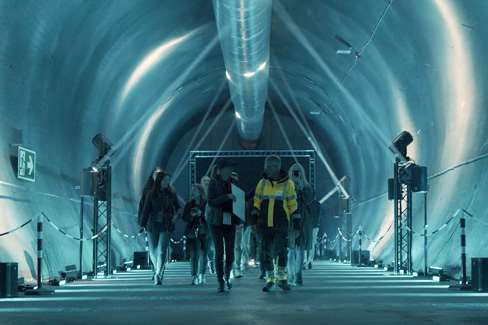
The visit to the power plant cavern is a unique experience.
Bailout
Federal government sends important signal for energy industry
5 September 2022
On 5 September 2022, at the request of Axpo, the Federal Council initiates the bailout scheme for systemically important Swiss energy companies by emergency decree. This automatically places Alpiq under the scheme with immediate effect. Alpiq welcomes the Swiss government’s decisive action, which sends an important confidence-building signal to the markets. The upheaval on the energy markets, which has persisted for many months, has prompted various countries to take measures to protect the security of supply against systemic risks.
With the entry into force of the Federal Act on Subsidiary Financial Assistance to Rescue Systemically Critical Companies in the Electricity Industry, Alpiq is automatically subject to the law and will comply with the associated obligations. However, Alpiq is not drawing on any federal assistance and is confident that it will not have to do so even if market conditions remain challenging. Comprehensive operational measures in the energy business, as well as additional financing in the credit and capital markets, have strengthened the company’s financial room for manoeuvre, which Alpiq is doing everything in its power to maintain.
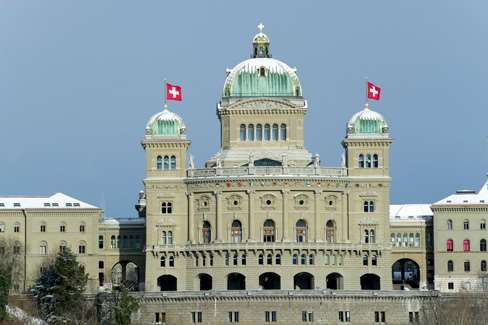
The Federal Palace of Switzerland in Bern.
Photo: Parlamentsdienste 3003 Bern / Béatrice Devènes
AS
Autumn session: Federal government sets the course for accelerated expansion of renewable energies
30 September 2022
The Swiss Parliament’s autumn session is dominated by the energy crisis. By adopting the urgent Federal Act on Subsidiary Financial Assistance in the autumn session, the National Council and Council of States create the legal basis for a CHF 10 billion rescue fund for the systemically critical electricity companies, namely the three companies Axpo, Alpiq and BKW. This act takes effect at 1 October 2022 and is limited until the end of 2026.
During consultation on the indirect counterproposal to the Glacier Initiative, Parliament launches a solar campaign and resolves on additional, urgent legislation to raise the Grimsel dam wall. By means of a simplified procedure, the solar campaign aims to pave the way for the expansion of alpine ground-mounted installations in the region of 2 TWh by the end of 2025. Alpiq is pursuing projects in Alpine regions that are affected by the legislation, for example Gondosolar and Prafleuri.
The Council of States was the first to start deliberations on the Federal Act on a Secure Electricity Supply from Renewable Energy Sources. It wants to rapidly expand domestic renewable energy sources and has therefore stepped up the expansion targets for 2035 and 2050 and has decided that hydropower storage power plants, pumped storage power plants, photovoltaic installations and wind power plants as well as electrolysers and methanisation installations are in the national interest if they make a central contribution to achieving the expansion targets. National interests take priority over conflicting interests of cantonal, regional and local significance. In the future, investors should be able to choose between an investment contribution or a floating market premium. As a sign of support for the expansion of hydropower, the 15 “Round Table” projects were added as an appendix to the legislation. Alpiq is directly involved in key projects (Gornerli, Oberaletsch and potential projects to raise dam walls).

Visualisation of the Gornerli reservoir near Zermatt.
prixalpiq
#prixalpiq 2022 goes to the “Regionale Wasserversorgung Südrampe” project in Valais
7 October 2022
In Martigny, the #prixalpiq for sustainable water management projects is awarded for the second time. The #prixalpiq 2022 is awarded to the “Regionale Wasserversorgung Südrampe” (Regional Water Supply of the Southern Ramp) project, supported by the municipalities of Visp, Naters, Brig-Glis and Lalden. The innovative intercommunal system of governance secures the regional supply of drinking water. The jury also awarded a “Winner of hearts” prize to the project “La Conquête de l’Eau” (The Conquest of Water) by the municipality of Ayent, a film about the value and importance of water resources and its preservation. The winning project receives CHF 40,000 and the “Winner of hearts” project receives CHF 10,000.
Alpiq, in partnership with the Association of Concession-Granting Municipalities of Valais (ACC), presents the winners with prizes worth a total of CHF 50,000 in a ceremony. “As has been made clear once again in the last few months, climate change is having a very real impact on our environment, especially when it comes to water management”, says Antje Kanngiesser, CEO of Alpiq.
The winning project “Regionale Wasserversorgung Südrampe” secures the supply of drinking water in the Brig-Naters-Visp agglomeration and meets the water needs of the municipalities and industry. The first stage of the project is completed in record time thanks to the intercommunal collaboration, which began in 2021. Since spring 2022, more than a million cubic metres of water have been injected into the water supply of the municipalities in the agglomeration. The next stage of the project is to extend this water supply system by constructing new pipes to guarantee access to drinking water until 2040. In addition, a turbine installation will use the waterfall to generate electricity.
The film project “La Conquête de l’Eau” wins the “Winner of hearts” prize. Produced by Artemis Films Production S.A. and sponsored by the municipality of Ayent, the film tells the story of the relentless struggle of our ancestors to find water in the Valais mountains. Faced with the current challenges of climate change, and particularly with periods of severe drought, the issue of water and its sustainable management now plays a major role in our society.
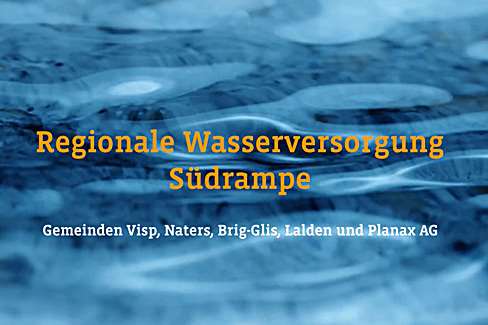
The winners of the second edition of the #prixalpiq award.
HR
Alpiq provides more than half of the hydropower reserve for winter 2022/2023
25 October 2022
The Swiss Federal Electricity Commission (ElCom) publishes the results of the auction for the hydropower reserve for winter 2022/2023. Alpiq participated in the auction held by national grid operator Swissgrid and submitted responsible bids. The result speaks for itself: Alpiq wins the contract for the entire bid, i.e. 218 GWh from seven different power plants. Alpiq is thus providing more than 50 % of the entire hydropower reserve and is making a substantial contribution to strengthening the security of supply in Switzerland, in order to bridge any critical moments in the winter months.
The hydropower reserve aims to ensure that the electricity supply in Switzerland can be guaranteed during a period of a few weeks towards the end of winter – even with higher domestic consumption, reduced availability in domestic power plants and fewer import opportunities. The hydropower reserve is a backup to bridge an unanticipated critical situation and, in doing so, contributes to strengthening the country’s security of supply.
A total of 149 bids totalling 672 GWh were submitted by various providers during the tender for the hydropower reserve. ElCom decided to award the contract to provide a hydropower reserve to bids with a total of 400 GWh. The quantities procured are thus within the pre-determined benchmarks, which propose 500 GWh with tolerance of +/-166 GWh.
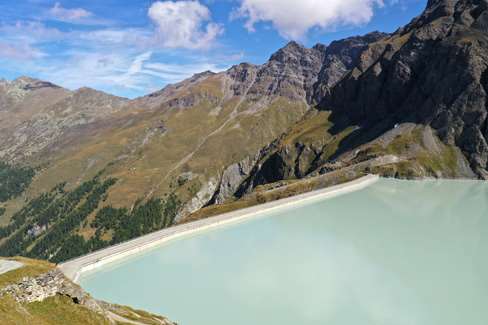
The Grande-Dixence reservoir holds 400 million cubic metres of water.